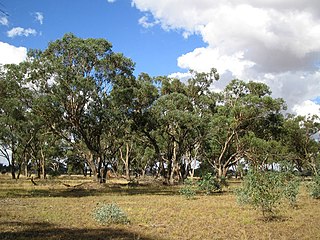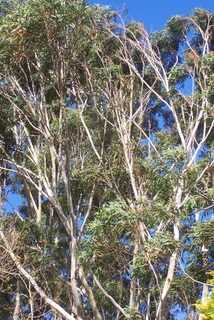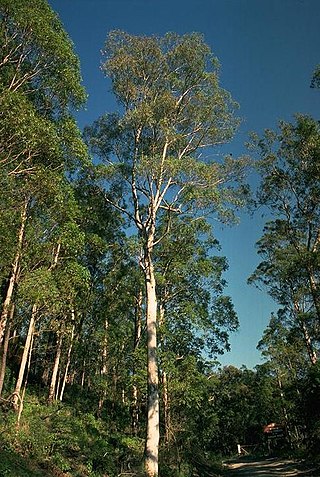
Eucalyptus coolabah, commonly known as coolibah or coolabah, is a species of tree found in eastern inland Australia. It has rough bark on part or all of the trunk, smooth powdery cream to pink bark above, lance-shaped to curved adult leaves, flower buds in groups of seven and hemispherical or conical fruit.

Eucalyptus olida is a species of small to medium-sized tree that is endemic to a restricted area of New South Wales, Australia. It has rough, flaky and fibrous bark on the trunk and larger branches, lance-shaped to curved adult leaves, flower buds in groups of seven to fifteen or more, white flowers and barrel-shaped or bell-shaped fruit.

Eucalyptus melliodora, commonly known as yellow box, honey box or yellow ironbark, is a species of medium-sized to occasionally tall tree that is endemic to south-eastern, continental Australia. It has rough, flaky or fibrous bark on part or all of the trunk, smooth greyish to yellowish bark above. The adult leaves are lance-shaped to egg-shaped, the flower buds are arranged in groups of seven and the fruit is more or less hemispherical.

Eucalyptus radiata, commonly known as the narrow-leaved peppermint or Forth River peppermint, is a species of tree that is endemic to south-eastern Australia. It has rough, fibrous to flaky bark on the trunk and larger branches, smooth grey bark on the thinner branches, lance-shaped to curved or almost linear leaves, flower buds in groups of eleven to twenty or more, white flowers and cup-shaped, hemispherical or shortened spherical fruit.

Eucalyptus dumosa, commonly known as the white mallee, dumosa mallee, or Congoo mallee, is a species of mallee that is endemic to south eastern Australia. It usually has rough, flaky grey bark on the lower trunk, smooth bark above, lance-shaped to curved adult leaves, flower buds in groups of seven, white flowers and cup-shaped, cylindrical or barrel-shaped fruit.

Eucalyptus muelleriana, commonly known as yellow stringybark, is a species of medium-sized to tall tree that is endemic to southeastern Australia. It has rough, stingy bark on the trunk and branches, lance-shaped to curved adult leaves, flower buds in groups of between seven and eleven, white flowers and cup-shaped to shortened spherical fruit.

Eucalyptus microcarpa, commonly known as grey box, is a species of tree that is endemic to southeastern continental Australia. It has rough, fibrous or flaky bark on the trunk, smooth whitish bark above, lance-shaped adult leaves, flower buds in groups of between seven and eleven, white flowers and oval, cylindrical or urn-shaped fruit.

Eucalyptus pilularis, commonly known as blackbutt, is a species of medium-sized to tall tree that is endemic to eastern Australia. It has rough, finely fibrous greyish bark on the lower half of the trunk, smooth white, grey or cream-coloured bark above, lance-shaped to curved adult leaves, flower buds in groups of between seven and fifteen, white flowers and hemispherical or shortened spherical fruit.

Eucalyptus albens, known as the white box, is a common tree of the western slopes and plains of New South Wales and adjacent areas in Queensland and Victoria. It has rough, fibrous bark on the base of its trunk and smooth, white bark above. The leaves are lance-shaped and groups of seven spindle-shaped flower buds are arranged in leaf axils or on the ends of the branches. White flowers are mostly present between August and February and the fruit are barrel-shaped to urn-shaped.

Eucalyptus conica, commonly known as fuzzy box, is a species of tree endemic to eastern Australia. It has rough, flaky bark on the trunk and larger branches, smooth above, lance-shaped adult leaves, oval to diamond-shaped flower buds mostly arranged on a branching inflorescence on the ends of the branchlets, white flowers and conical fruit.

Eucalyptus badjensis, commonly known as the Big Badja gum, is a tree that is endemic to south-eastern New South Wales. It has hard, rough bark on the lower part of the trunk, smooth grey bark above, often hanging in strips on the upper branches, linear to narrow lance-shaped, often curved adult leaves, green to yellow buds in groups of three in leaf axils, white flowers and conical or bell-shaped fruit.

Eucalyptus dendromorpha, the Budawang ash or giant mallee ash is a species of tree endemic to southeastern Australia. It has rough, compacted bark on the lower part of the trunk, smooth white to cream-coloured bark above, lance-shaped to curved adult leaves, flower buds in groups of between seven and eleven, white flowers and cup-shaped or barrel-shaped fruit.

Eucalyptus porosa, commonly known as mallee box, Quorn mallee or water mallee, is a species of mallee or a tree that is endemic to southern Australia. It has rough, fibrous or flaky bark on the trunk and larger branches, smooth greyish bark above, lance-shaped adult leaves, flower buds in groups of seven, white flowers and barrel-shaped or shortened spherical fruit.

Eucalyptus foecunda, commonly known as narrow-leaved red mallee, Fremantle mallee or coastal dune mallee, is a species of plant in the myrtle family that is endemic to Western Australia. It has rough bark on the trunk, smooth bark above, narrow lance-shaped adult leaves, flower buds in groups of nine or eleven, creamy white flowers and cup-shaped fruit. It was previously included with the more widespread Eucalyptus leptophylla.

Eucalyptus intertexta, commonly known as inland red box, western red box, gum coolibah or the bastard coolibah, is a species of tree that is endemic to central Australia. It has rough, fibrous or flaky bark on the base of the trunk, smooth white to brownish bark above, lance-shaped adult leaves, flower buds in groups of seven on the ends of branchlets, white flowers and cup-shaped to hemispherical fruit.

Eucalyptus largeana, commonly known as the Craven grey box, is a species of medium-sized to tall tree that is endemic to a restricted area of New South Wales. It has rough, fibrous or flaky bark on the trunk and larger branches, smooth greyish bark above, lance-shaped adult leaves, flower buds in groups of seven, white flowers and cup-shaped or barrel-shaped fruit.

Eucalyptus magnificata, commonly known as blue box or northern blue box, is a species of small tree or sometimes a mallee that is restricted to a small area of New South Wales. It has rough, fibrous or flaky bark on the trunk and larger branches, smooth bark above, broadly lance-shaped to egg-shaped leaves, flower buds in groups of seven, white or pale yellow flowers and conical fruit.

Eucalyptus bakeri, commonly known as Baker's mallee or the mallee box, is a eucalypt that is endemic to eastern Australia. It has fibrous bark on the trunk and smooth white or grey bark above, narrow lance-shaped leaves, flower buds in groups of between seven and thirteen, white flowers and hemispherical or shortened spherical fruit.
Eucalyptus lockyeri, commonly known as Lockyer's box, is a species of small tree endemic to a small area in Queensland. It has rough bark near the base of the trunk, smooth bark above, lance-shaped adult leaves, flower buds in groups of seven, white flowers and hemispherical fruit.
Eucalyptus silvestris is a species of mallee or small tree that is endemic to Victoria, Australia. It has rough, fibrous or flaky bark on the trunk and larger branches, smooth greyish brown bark above, glossy green, lance-shaped leaves, flower buds usually in groups of seven, white flowers and conical to cup-shaped fruit.






















